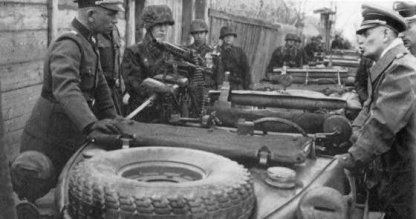In 1941 a considerable number of
Flemish speaking Belgians volunteered to join the
Waffen SS and were despatched to the Nordwest
Standarte and sent off for basic training in Poland.
It was here that the Freiwilligen Standarte Nordwest
was formed and later in September it became a
motorised infantry unit known as the SS-Freiwilligen
Legion Flandern. At this point there strength
consisted of just over 1000 men. It's first taste of
action came in the Wolchow region of the eastern
front and later in 1942 they were engaged in heavy
combat in the Leningrad sector.
In the Spring of 1943 the legion
was withdrawn from the front and moved to Milowitz
near Prague for reorganisation into a brigade,
incorporating new drafts of Flemish and some Finnish
personnel. Now known as the 6th SS-Freiwilligen
Sturmbrigade "Langemarck" they were sent
back to the training ground at Debica for further
training and were also equipped with an anti-tank
company, self propelled gun battalion and flak
battalion.
 In December 1943 the
6th SS-Freiwilligen Sturmbrigade was sent to the
Ukraine and was badly hit by Soviet forces near
Zhitomir in early 1944. Later in April it was
withdrawn for rest and refit in Bohmen,
Czechoslovakia and it was in July that Kampfgruppe
"Rehmann" was formed from part of the
Sturmbrigade to fight in the Narva area. They fought
along with other European volunteer formations
notably the 20th SS Estonian Division and the
fighting that took place was extremely bitter and at
one point the 6th SS-Freiwilligen Sturmbrigade lost
several of it's senior officer's to Soviet artillery.
In September the survivors were shipped to Sweinmunde
and from there to the depot at Hammerstein. On 18th
September an order from Himmler authorised the
formation of a Flemish division based on the remains
of the brigade to which would be added Flemings who
were serving with the Luftwaffe, NSKK, Kriegsmarine
and Todt Organisation. On the 18th of October, 1944
the Sturmbrigade was renamed as 27th
SS-Freiwilligen-Grenadier-Division
"Langemarck" but it should be remembered
though that although the title of
"division" was bestowed on this formation
it never exceeded regimental strength. This new
"division" saw combat in early 1945 in
Zachen and over the next two months fought against
Soviet forces in Stargard and Altdamm. Later in April
some sub units fought on the Oder Front and finally
in Mecklemburg in May 1945 where the division
surrendered.
In December 1943 the
6th SS-Freiwilligen Sturmbrigade was sent to the
Ukraine and was badly hit by Soviet forces near
Zhitomir in early 1944. Later in April it was
withdrawn for rest and refit in Bohmen,
Czechoslovakia and it was in July that Kampfgruppe
"Rehmann" was formed from part of the
Sturmbrigade to fight in the Narva area. They fought
along with other European volunteer formations
notably the 20th SS Estonian Division and the
fighting that took place was extremely bitter and at
one point the 6th SS-Freiwilligen Sturmbrigade lost
several of it's senior officer's to Soviet artillery.
In September the survivors were shipped to Sweinmunde
and from there to the depot at Hammerstein. On 18th
September an order from Himmler authorised the
formation of a Flemish division based on the remains
of the brigade to which would be added Flemings who
were serving with the Luftwaffe, NSKK, Kriegsmarine
and Todt Organisation. On the 18th of October, 1944
the Sturmbrigade was renamed as 27th
SS-Freiwilligen-Grenadier-Division
"Langemarck" but it should be remembered
though that although the title of
"division" was bestowed on this formation
it never exceeded regimental strength. This new
"division" saw combat in early 1945 in
Zachen and over the next two months fought against
Soviet forces in Stargard and Altdamm. Later in April
some sub units fought on the Oder Front and finally
in Mecklemburg in May 1945 where the division
surrendered.
.
Short history of Remy Richard
Schrijnen (1921- )

Perhaps the most famous member of
this division and only Knights Cross winner was Remy
Schrijnen who knocked out 13 Russian tanks single
handedly after his gun crew were either killed or
wounded. This brave man was born in Kumtich,
Flanders, Belgium on the 24th of December 1921. He
started out as a SS-Unterscharfuhrer der Reserve. In
September 1944 he was promoted to SS-Sturmmann just
because of his heroic actions. In that period he
served under the 3.Komp./SS-Freiw.Sturmbrigade
"Langemarck". It is not clear that just
after the war he surrendered to either the British or
American forces. From 1945 to 1950 he was imprisoned
by Belgian autorities, and again taken in custody in
1955. He was not released until January 1955.
.
Decorations & Awards:
Ritterkreuz des E.K.: 21. 09. 1944
as SS-Sturmmann, Richtschutze eines schweren
Pakgeschutzes i.d.
3.(Panzerjager)Komp./SS-Freiw.Sturmbrigade
"Langemarck" / III.(germ.) SS-Pz.Korps /
Heeresgruppe Nord, Eastern Front
1939 EK I: 3.08.1944
1939 EK II: 28.05.1944
Verwundetenabzeichen, 1939 in Gold
Verwundetenabzeichen, 1939 in
Silber
Verwundetenabzeichen, 1939 in
Schwarz
Infanterie-Sturmabzeichen in Bronze
